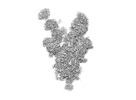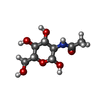+Search query
-Structure paper
| Title | Potent monoclonal antibodies neutralize Omicron sublineages and other SARS-CoV-2 variants. |
|---|---|
| Journal, issue, pages | Cell Rep, Vol. 41, Issue 5, Page 111528, Year 2022 |
| Publish date | Nov 1, 2022 |
 Authors Authors | Zhaochun Chen / Peng Zhang / Yumiko Matsuoka / Yaroslav Tsybovsky / Kamille West / Celia Santos / Lisa F Boyd / Hanh Nguyen / Anna Pomerenke / Tyler Stephens / Adam S Olia / Baoshan Zhang / Valeria De Giorgi / Michael R Holbrook / Robin Gross / Elena Postnikova / Nicole L Garza / Reed F Johnson / David H Margulies / Peter D Kwong / Harvey J Alter / Ursula J Buchholz / Paolo Lusso / Patrizia Farci /  |
| PubMed Abstract | The emergence and global spread of the SARS-CoV-2 Omicron variants, which carry an unprecedented number of mutations, raise serious concerns due to the reduced efficacy of current vaccines and ...The emergence and global spread of the SARS-CoV-2 Omicron variants, which carry an unprecedented number of mutations, raise serious concerns due to the reduced efficacy of current vaccines and resistance to therapeutic antibodies. Here, we report the generation and characterization of two potent human monoclonal antibodies, NA8 and NE12, against the receptor-binding domain of the SARS-CoV-2 spike protein. NA8 interacts with a highly conserved region and has a breadth of neutralization with picomolar potency against the Beta variant and the Omicron BA.1 and BA.2 sublineages and nanomolar potency against BA.2.12.1 and BA.4. Combination of NA8 and NE12 retains potent neutralizing activity against the major SARS-CoV-2 variants of concern. Cryo-EM analysis provides the structural basis for the broad and complementary neutralizing activity of these two antibodies. We confirm the in vivo protective and therapeutic efficacies of NA8 and NE12 in the hamster model. These results show that broad and potent human antibodies can overcome the continuous immune escape of evolving SARS-CoV-2 variants. |
 External links External links |  Cell Rep / Cell Rep /  PubMed:36302375 / PubMed:36302375 /  PubMed Central PubMed Central |
| Methods | EM (single particle) |
| Resolution | 2.9 - 3.5 Å |
| Structure data |  EMDB-26401: SARS-CoV-2 spike trimer in complex with Fab NE12, ensemble map EMDB-26402: SARS-CoV-2 spike trimer in complex with Fab NE12, local refinement map  EMDB-26403: SARS-CoV-2 spike trimer in complex with Fab NA8, ensemble map EMDB-26404: SARS-CoV-2 spike trimer in complex with Fab NA8, local refinement map |
| Chemicals |  ChemComp-NAG: |
| Source |
|
 Keywords Keywords |  VIRAL PROTEIN/IMMUNE SYSTEM / VIRAL PROTEIN/IMMUNE SYSTEM /  SARS-CoV-2 / SARS-CoV-2 /  COVID19 / COVID19 /  spike protein / spike protein /  antibody / antibody /  VIRAL PROTEIN-IMMUNE SYSTEM complex VIRAL PROTEIN-IMMUNE SYSTEM complex |
 Movie
Movie Controller
Controller Structure viewers
Structure viewers About Yorodumi Papers
About Yorodumi Papers









